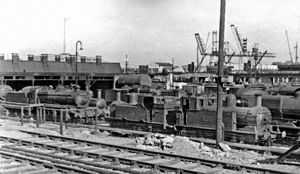GS&WR Class 201
| Great Southern & Western Railway Class 201 | |
|---|---|
|
Class 201 No. 220 (right foreground) at Cork (Glanmire Road) Locomotive Depot, 17 July 1955 | |
| Type and origin | |
| Power type | Steam |
| Designer | H. A. Ivatt |
| Builder | Inchicore Works |
| Build date | 1887 (4), 1895 (2), 1901 (4) |
| Total produced | 10 |
| Specifications | |
| Configuration | 0-6-0T |
| UIC classification | C n2t |
| Gauge | 5 ft 3 in (1,600 mm) |
| Driver diameter | 4 feet 6 1⁄2 inches (1.384 m) |
| Axle load |
1887/1895 locos: 15 long tons 0 cwt (33,600 lb or 15.2 t), 1901 locos: 15 long tons 10 cwt (34,700 lb or 15.7 t) |
| Locomotive weight |
1887 locos: 40 long tons 5 cwt (90,200 lb or 40.9 t), 1895 locos: 42 long tons 15 cwt (95,800 lb or 43.4 t), 1901 locos: 43 long tons 16 cwt (98,100 lb or 44.5 t) |
| Fuel type | Coal |
| Fuel capacity |
1887 locos: 2 long tons 0 cwt (4,500 lb or 2 t) 1895/1901 locos: 1 long ton 10 cwt (3,400 lb or 1.5 t) |
| Water capacity |
1887 locos: 945 imp gal (4,300 l; 1,135 US gal) 1895/1901 locos: 730 imp gal (3,300 l; 880 US gal) |
| Boiler pressure | 150 to 160 psi (1.03 to 1.10 MPa) |
| Firegrate area | 18.8 to 19.3 sq ft (1.75 to 1.79 m2) |
| Heating surface: – Tubes | 823 to 938 sq ft (76.5 to 87.1 m2) |
| – Firebox | 105 to 112.5 sq ft (9.75 to 10.45 m2) |
| Cylinders | Two, inside |
| Cylinder size | 18 in × 24 in (0.46 m × 0.61 m) |
| Performance figures | |
| Tractive effort | 18,200 to 19,400 lbf (80.96 to 86.30 kN) |
| Career | |
| Operator(s) | GS&WR → GSR → CIÉ |
| Class |
GS&WR: 201 GSR/CIÉ: 201 or J11 |
| Number(s) | 201, 202, 207–210, 217–220 |
| Withdrawn | 1949–1963 |
The Great Southern and Western Railway Class 201 was a class of ten 0-6-0 side tank locomotives designed by Locomotive Engineer, H. A. Ivatt in 1887 for shunting heavy goods trains at Kingsbridge and Cork yards.
Constraints on the locomotive design meant that the coupled wheelbase had to be as short as possible to negotiate the curves in the dock areas but the locomotive had to have sufficient power available for the increasing load of the trains.
Under the system employed by the Great Southern Railways they became Class J11. The class survived until the mid to late 1950s, still working in the Cork area.
References
- Clements, Jeremy & McMahon, Michael (2008). Locomotives of the GSR. Newtownards: Colourpoint Books. pp. 84–85. ISBN 978-1-906578-26-8.
See also
- Diesel Locomotives of Ireland
- Multiple Units of Ireland
- Coaching Stock of Ireland
- Steam locomotives of Ireland
| ||||||||||||||||||||||||||||||||||||||||||||||||||
